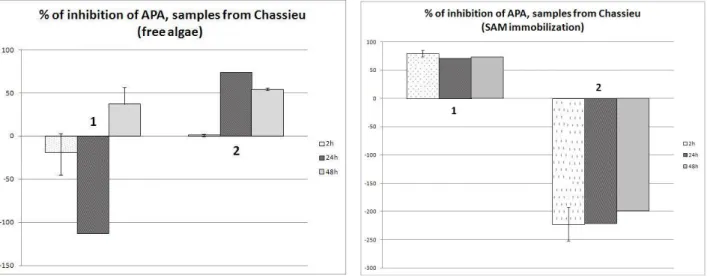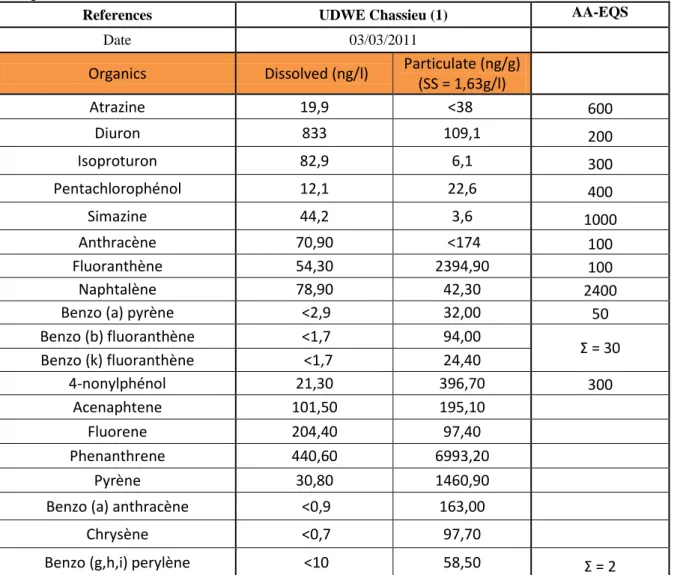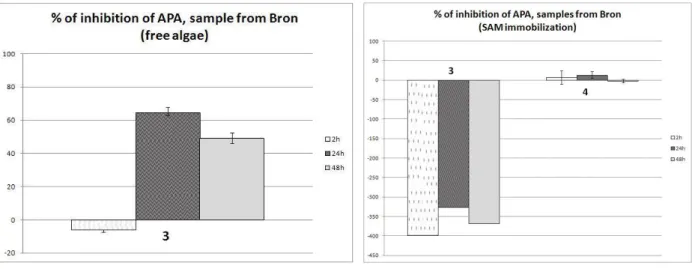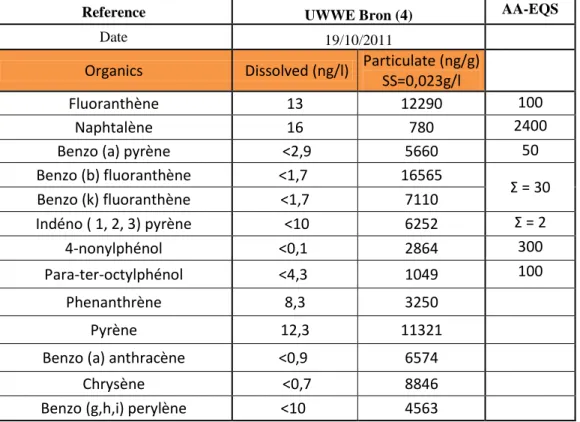HAL Id: hal-00763753
https://hal.archives-ouvertes.fr/hal-00763753
Submitted on 11 Dec 2012
HAL is a multi-disciplinary open access archive for the deposit and dissemination of sci-entific research documents, whether they are pub-lished or not. The documents may come from teaching and research institutions in France or abroad, or from public or private research centers.
L’archive ouverte pluridisciplinaire HAL, est destinée au dépôt et à la diffusion de documents scientifiques de niveau recherche, publiés ou non, émanant des établissements d’enseignement et de recherche français ou étrangers, des laboratoires publics ou privés.
DEVELOPMENT OF AN ALGAL BIOSENSOR FOR
TOXICITY ASSESSMENT OF URBAN WET
WEATHER EFFLUENTS
Yannis Ferro, Claude Durrieu
To cite this version:
Yannis Ferro, Claude Durrieu. DEVELOPMENT OF AN ALGAL BIOSENSOR FOR TOXICITY ASSESSMENT OF URBAN WET WEATHER EFFLUENTS. SIDISA 2012 Sustainable Technology for Environmental Protection, Jun 2012, Milan [Politecnico di Milano], Italy. [ID 829] page 178. �hal-00763753�
1
DEVELOPMENT OF AN ALGAL BIOSENSOR FOR
TOXICITY ASSESSMENT OF URBAN WET WEATHER
EFFLUENTS
Y. Ferro1, C. Durrieu1
1 Université de Lyon ; UMR5023 Ecologie des Hydrosystèmes Naturels et Anthropisés ; Université Lyon 1 ; ENTPE ; CNRS ; 3, rue Maurice Audin, 69518 Vaulx-en-Velin, France. yannis.ferro@entpe.fr
Abstract
Stormwater runoff from urban areas generates various pollutants (suspended solids, heavy metals, polycyclic aromatic hydrocarbons, nutrients...) This cocktail of pollutants can contribute to adverse quality of receiving water bodies (urban streams, ground water). In order to preserve aquatic ecosystems it is therefore necessary to evaluate quality and toxicity of wet weather effluents. In this work dry and wet weather effluents were sampled and different ecotoxicological assays based on enzymatic activity measurementwere performed. Results of bioassays with free algae were compared to results obtained with a conductometric biosensor. Differences of results between both toxicity evaluation methods are linked to the chemical composition of effluents and the sensibility of the chosen test. This study shows the ability of the sensor to evaluate toxicity of urban effluents and its interest in environmental pollution monitoring.
Keywords
biosensors; environmental monitoring; storm water INTRODUCTION
Urban wet weather effluents (UWWE) consist of all water discharged from sewage treatment plants, sewer overflows and stormwater outfalls during a storm event and the time period that follows it, the sewerage sanitation have not yet found a nominal operation of dry weather (Chocat, Bertrand-Krajewski, et al., 2007). Many studies have shown the contamination of these effluents by various compounds: heavy metals, polycyclic aromatic hydrocarbons (PAHs), polychlorobiphenyls (PCBs), pesticides, organotins, volatile organic compounds, chlorobenzenes, phthalates and alkylphenols (Eriksson, Baun, et al., 2007; Gasperi, Garnaud, et al., 2008; Jartun and Pettersen, 2010; Karlsson, Viklander, et al., 2010). These periodic discharges contribute to the chronic pollution of urban stream and ground water.
Although today contamination of these effluents is well known, few studies have been undertaken to evaluate their impact on aquatic ecosystems/receiving water bodies. Environmental monitoring of pollutants with automatic systems, applied online and allowing rapid response is one of the best ways to control the quality of the environment. Real time analysis offers the advantage of detecting rapidly the presence of pollutants before they cause any damages. Such a strategy is only possible through biosensors.
In this work, algal whole cell based biosensor has been used to assess toxicity of urban wet or dry weather effluents, which flow in urban river or retention tanks. Samples came from an overflow device and two retention/infiltration tanks located near Lyon (France). At the same time, free algae bioassays have been carried out and results were compared.
METHOD AND MATERIALS
Algal cultures
Experiments were carried out with Chlorella vulgaris, a freshwater strain. C. vulgaris (Chlorophycea) is a non motile unicellular green algae common in fresh water. This strain is often used in ecotoxicology thanks its ecological advantages, in particular C. vulgaris can accumulate large quantities of pollutants. The C. vulgaris strain (CCAP 211/12) was purchased from The Culture Collection of Algae and Protozoa at Cumbria, United Kingdom. The algal strain was grown in the culture medium (AFNOR T90-304, 1980) with a photoperiod of 16h light/8h dark.
2
Sampling sites
Three different sampling sites have been chosen according to the occupation of watershed.
- The first site, located in Ecully at the west of Lyon is an overflow device which discharges effluents in a suburban stream. The sewer system is combined; the area occupation is mainly residential, covering a surface of 245 ha of about 7,000 people equivalent and impervious to 45%;
- The second site, located in Chassieu at the east of Lyon and nicknamed “Django Reinhardt”, is a retention/infiltration tank which collects water from an area of primarily industrial land use. It covers a surface of 185 ha with a total impervious about 72%;
- The last site, located in Bron at the east of Lyon, is a retention/infiltration tank which collects water from a lorry park of 3.5 ha.
Samples were collected by wet weather and dry weather for Chassieu and Ecully and only by wet weather on Bron site.
Table 1:characteristics of sampling campaigns
Site Chassieu Bron Ecully Occupation
of watershed Industrial Lorry park Residential Dry weather
samples sample (1) 03/03/2011 / sample (5) 03/03/2011 Analyses Ions, metals & organics / Ions, metals & organics Wet weather samples sample (2) 13/07/2011 Sample (3) 13/07/2011 Sample (4) 19/10/2011 sample (6) 24/02/2011 Analyses Ions & metals Ions & metals Ions, metals
& organics Ions & metals
Analytical methods
Ions: levels of NO3-;PO42-; SO42-and K+ were determined by ionic chromatography (IC, Thermo
Scientific Dionex DX-100);
Metals: levels of Pb, Ni, Cu and Zn were determined by Atomic absorption spectroscopy (AAS, Hitachi Z-8200);
Organics: Gas chromatography associated to time-of-flight mass spectrometry (GC-ToF, AGILENT 6890N) and high performance liquid chromatography associated to tandem mass spectrometry (LC-MS/MS, AGILENT 100/1200 for LC and ABSciex/3200 QTRAP for MS).
Toxicity measurements
Bioassays
Bioassays were carried out in 48 wells microplates with free algae; they were based on fluorescence measurements (Fluostar BMG) linked to the enzymatic activity. Methylumbelliferyl Phosphate (MUP), dissolved at different concentrations (between 2 and 18 µM) in a Tris– HCl (0.1M, pH 8.4) buffer solution was used as substrate of the alkaline phosphatase enzymatic reactions. Methylumbelliferone (MUF), the fluorescent product of the reaction, was detected within fluorescent parameters (λexcitation =365nm and λemission =460 nm) (Durrieu, Badreddine, et al., 2003). For each substrate concentration, three replicates were carried out.
For bioassays, 48 wells microplates were filled with algal solution. After sedimentation, culture medium could be removed and replaced by test solution (or algal culture medium for control). Exposures last 2h, 24h and 48h. After removing the test solution and resuspending algae in distilled water, fluorescence measurements were carried out. Km and Vm values were determined using
3
Lineweaver-Burk linearization (Cornish-Bowden, Jamin, et al., 2005). The ratio Km/Vm, specific
time of enzyme, is used as a parameter representative of enzymatic activity (the specific time is the time required to consume all the substrate). Inhibition rate of APA is defined as:
(1)
Biosensors
The conductometric transducers were fabricated at the Institute of Chemo-and Biosensors (Munster Germany) (Trebbe, Niggemann, et al., 2001). Two pairs of Au (150 nm thick) interdigitated electrodes were made by the lift-off process on the Pyrex glass substrate. The Cr intermediate layer of 50 nm thick was used to improve adhesion of Au to substrate. Central part of the sensor chip was passivated by AlO3 layer to define the electrodes working area. Both the digits width and
interdigital distance were 20 nm and their length was about 1mm. Thus, the sensitive part of each electrode was about 1,5 mm2. Measurements are based on the detection of solution conductivity variation inside algal cells immobilized. The technique of immobilization consists in the formation of a self-assembled monolayer of algae (SAM) (Guedri and Durrieu, 2008).
Measurements were carried out under daylight at room temperature for Alkaline Phosphatase Activity (APA) in a 2 ml glass cell filled with buffer (Tris-HCl, 0.1 M, pH 8.4). The biosensor was preincubated in a test solution (or in algal culture medium for control) for 2h, 24h and 48h. After washingbiosensors were immersed in this vigorously stirred solution. After stabilisation of the output signal, 10 µl of the substrat (paranitrophenyl phosphate) were added into the vessel. The differential output signal (dS) was registered using a “home made” conductometric laboratory;dS control and dS test were compared and the inhibition rate was calculated as following:
(2)
RESULTS AND DISCUSSION
Results are expressed as percent of control before exposure. They are expressed in terms of percentage of inhibition, i.e. the percentage of activity compared to a control treated under the same conditions of the test, but with the sample replaced by algal culture medium.
Annual average environmental quality standards (AA-EQS) are definite according to Directive 2008/105/EC of the European Parliament and of the Council of 16 December 2008.
Samples from Chassieu
Figure 1: results of bioassay after exposure
to sample (1) and (2)
Figure 2: results of biosensors after exposure
4 Table 2: ions and metals concentration for dissolved fraction of sample (1) and (2)-comparison with
AA-EQS
References UDWE Chassieu (1) UWWE Chassieu (2) AA-EQS
Date 03/03/2011 13/07/2011
Ions Dissolved fraction
NO3- (mg/l) 16,1 6,5
PO42- (mg/l) 0,5 <0,1
SO42- (mg/l) 38 3,3
K+ (mg/l) 5,7 1,3
Metals Dissolved fraction
Pb (µg/l) < 2 < 2 7,2
Ni (µg/l) 20,13 2,89 20
Cu (µg/l) 3,22 9,41
Zn (µg/l) 220 < 2
Tableau 3: organics concentration for dissolved fraction and suspend solids (SS) of sample (1) -
comparison with AA-EQS
References UDWE Chassieu (1) AA-EQS
Date 03/03/2011
Organics Dissolved (ng/l) Particulate (ng/g)
(SS = 1,63g/l) Atrazine 19,9 <38 600 Diuron 833 109,1 200 Isoproturon 82,9 6,1 300 Pentachlorophénol 12,1 22,6 400 Simazine 44,2 3,6 1000 Anthracène 70,90 <174 100 Fluoranthène 54,30 2394,90 100 Naphtalène 78,90 42,30 2400
Benzo (a) pyrène <2,9 32,00 50
Benzo (b) fluoranthène <1,7 94,00 Σ = 30 Benzo (k) fluoranthène <1,7 24,40 4-nonylphénol 21,30 396,70 300 Acenaphtene 101,50 195,10 Fluorene 204,40 97,40 Phenanthrene 440,60 6993,20 Pyrène 30,80 1460,90
Benzo (a) anthracène <0,9 163,00
Chrysène <0,7 97,70
Benzo (g,h,i) perylène <10 58,50 Σ = 2
Bioassays
With free algae assays, inhibition of APA is around 50% with both samples after 48h of exposure.Chemical analyses show an important organic contamination of suspended solids by PAHs and dissolved matters by pesticides.
5
Biosensors
With dry weather effluent (sample 1) activity of the biosensor is strongly inhibited (more than 50%) and this, from 2h to 48h of exposure. This inhibition can be related to the presence of Ni (220 µg/l), pesticides (833 µg/l) and PAHs in suspended solids (up to 7 ppm). With wet weather effluent (sample 2) APA is strongly enhanced. In previous works we have shown that small amount of heavy metal ions (< 100 µg/l) enhance algal APA (Chouteau, Dzyadevich, et al., 2005). In the sample 2 metal contamination is very small (inf. to EQS) and could explain the enhancement of APA.
With the biosensors there are important differences about enzymatic activities between algae exposed to sample 1 and algae exposed to sample 2 which not exist with bioassays. Biosensors are more sensitive than bioassays and could integrate chemical differences between the two samples.
Samples from Bron
Table 4:ions and metals concentration for dissolved fraction of sample (3) and (4)-comparison with
AA-EQS
Reference UWWE Bron (3) UWWE Bron (4) AA-EQS
Date 13/07/2011 19/10/2011
Ions Dissolved fraction
NO3- (mg/l) <0,1 /
PO42- (mg/l) <0,1 /
SO42- (mg/l) 1,6 /
K+ (mg/l) 6,5 /
Metals Dissolved fraction
Pb (µg/l) < 2 < 2 7,2
Ni (µg/l) < 2 < 2 20
Cu (µg/l) 4,04 15,42
Zn (µg/l) < 2 < 2
Figure 3: results of bioassays after
6 Table 5:organics concentration for dissolved fraction and suspend solids (SS) of sample (4) -
comparison with AA-EQS
Reference UWWE Bron (4) AA-EQS
Date 19/10/2011
Organics Dissolved (ng/l) Particulate (ng/g) SS=0,023g/l
Fluoranthène 13 12290 100
Naphtalène 16 780 2400
Benzo (a) pyrène <2,9 5660 50
Benzo (b) fluoranthène <1,7 16565 Σ = 30 Benzo (k) fluoranthène <1,7 7110 Indéno ( 1, 2, 3) pyrène <10 6252 Σ = 2 4-nonylphénol <0,1 2864 300 Para-ter-octylphénol <4,3 1049 100 Phenanthrène 8,3 3250 Pyrène 12,3 11321
Benzo (a) anthracène <0,9 6574
Chrysène <0,7 8846
Benzo (g,h,i) perylène <10 4563
Bioassays
With sample 3, free algae assays show an inhibition of APA around 50% after 24h and 48h of exposure.
Biosensors
Contrary to bioassays, when they are exposed to sample 3, biosensors respond as previously (with sample 2). The sample 3 enhances APA with biosensors, probably because of the small metal concentrations. With sample 4 APA of biosensors is almost the same as the control. According to the land occupation, suspended solids of the sample 4 are strongly contaminated by PAH’s (more than 10 ppm) but suspended solids concentration is very small (23 mg/l) and the dissolved fraction presents only few contamination. That’s why APA is not influenced by the sample 4.
Samples from Ecully
Figure 5: results of bioassay after
exposure to sample (5) and (6)
Figure 6: results of biosensors after
7 Table 6:ions and metals concentration for dissolved fraction of sample (5) and (6)-comparison with
AA-EQS
Reference UDWE Ecully (5) UWWE Ecully (6) AA-EQS
Date 03/03/2011 24/02/2011
Ions Dissolved fraction
NO3- (mg/l) 134 108,5
PO42- (mg/l) 10,7 6,5
SO42- (mg/l) 52,3 30,8
K+ (mg/l) 17,8 11,3
Metals Dissolved fraction
Pb (µg/l) < 2 < 2 7,2
Ni (µg/l) < 2 <2 20
Cu (µg/l) 26,78 18,92
Zn (µg/l) < 2 < 2
Table 7: organics concentration for dissolved fraction and suspend solids (SS) of sample (4) - comparison with AA-EQS
Reference UDWE Ecully (5) AA-EQS
Date 03/03/2011
Organics Dissolved (ng/l) Particulate (ng/g) SS=0,36g/l Atrazine 2,9 <38 600 Diuron 25 <39 200 Simazine 2,8 <45 1000 Fluoranthène <0,5 58,60 100 Naphtalène 35,00 48,60 2400 Phenanthrene 9,50 141,90 Bioassays
Free algae assays are quite the same with sample 5 and sample 6. For both there is a strong inhibition of APA after 24h of exposure, and this from 2h for sample 6.
Biosensors
Results obtained with biosensors give the same results as those obtained with samples collected on Chassieu site, i.e. an inhibition of APA with dry weather sample and an enhancement with wet weather sample.
CONCLUSION
In this work, inhibition of enzymatic activities can be considered as efficient early toxicity signals of the presence of pollutants in samples. Bioassays with free algae already give us information about contamination of test sample and about its toxicity. However these results could be improved: the sensibility is low and assays could not be undertaken on the field. Responses of biosensors change relative to bioassays, these differences are linked to the chemical composition of effluent and the sensibility of the biosensor.
This study allowed us to test the reaction of whole cell conductometric biosensor with real complex effluent. To date this biosensor was able to detect heavy metal as cadmium with detection limit of 1 ppb and with good repeatability. Thanks to these experiments we have shown the capacities of the sensor to detect dangerousness of urban effluents and even more, to make the difference between dry weather effluents and wet weather effluents.
The next step is the implementation of these biosensors in situ for the monitoring of urban effluents and the development of early warning systems.
8 REFERENCES
Chocat, B., Bertrand-Krajewski, J.-L., and Barraud, S. (2007) Eaux pluviales urbaines et rejets urbains par temps de pluie. Techniques de l’ingénieur. Technologies de l'eau, 2(n°W6800)
Chouteau, C., Dzyadevich, S., Durrieu, C, and Chovelon J. (2005) A bi-enzymatic whole cell conductometric biosensor for heavy metal ions and pesticides detection in water samples.
Biosensors and Bioelectronics, 21, 273-281.
Cornish-Bowden, A., Jamin, M., and Saks, V. (2005) Cinétique enzymatique, EDP Sciences.
Durrieu, C, Badreddine, I., and Daix, C. (2003) A dialysis system with phytoplankton for monitoring chemical pollution in freshwater ecosystems by alkaline phosphatase assay.
Journal of Applied Phycology, 289-295.
Eriksson, E., Baun, A., Scholes, L, Ledin, A., Ahlman, S., Revitt, M, Noutsopoulos, C., and Mikkelsen, P. S. (2007) Selected stormwater priority pollutants -- a European
perspective.Science of the Total Environment, 383(1-3), 41-51.
Gasperi, J., Garnaud, S., Rocher, V., and Moilleron, R. (2008) Priority pollutants in wastewater and combined sewer overflow.The Science of the total environment, 407(1), 263-72.
Guedri, H. and Durrieu, C. (2008) A self-assembled monolayers based conductometric algal whole cell biosensor for water monitoring. Microchimica Acta, 163(3), 179-184.
Jartun, M. and Pettersen, A. (2010) Contaminants in urban runoff to Norwegian fjords. Journal of
Soils and Sediments, 10(2), 155-161.
Karlsson, K., Viklander, M., Scholes, L., and Revitt, M. (2010) Heavy metal concentrations and toxicity in water and sediment from stormwater ponds and sedimentation tanks. Journal of
Hazardous Materials, 178(1-3), 612-618.
Trebbe, U., Niggemann, M., Cammann, K., Fiaccabrino, G., Koudelka-Hep, M., Dzyadevich, S., Shulga, O. (2001) A new calcium-sensor based on ion-selective conductometric microsensors - membranes and features. FRESENIUS JOURNAL OF ANALYTICAL CHEMISTRY, 371(6), 734-739.





